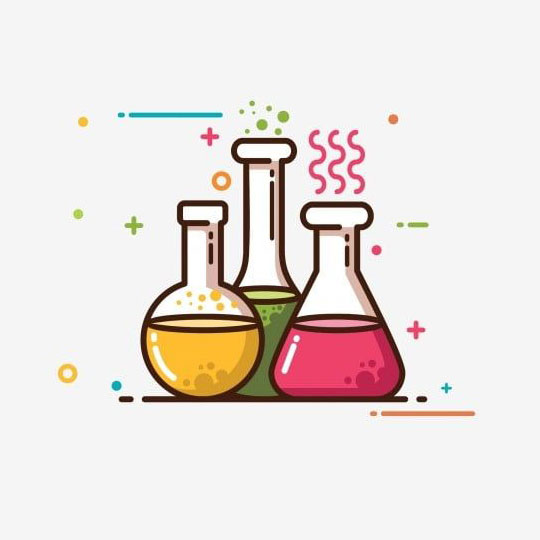Focusing Class 11th
Specially designed study material for Class 11 as per CBSE guidelines
Unlimited DOUBT Solving Classes for FREE!
Complete Conceptual Understanding
Advanced study material for competitive exams(IIT-JEE/NEET)
Test Series for Practice

Chemistry is the branch of science that deals with the composition, structure and properties of matter. It is a natural science that covers the elements that make up matter to the compounds composed of atoms, molecules and ions: their composition, structure, properties, behavior and the changes they undergo during a reaction with other substances.
General Introduction: Importance and scope of Chemistry. Atomic and molecular masses, mole concept and molar mass, percentage composition, empirical and molecular formula, chemical reactions, stoichiometry and calculations based on stoichiometry.
Bohr's model and its limitations, concept of shells and subshells, dual nature of matter and light, de Broglie's relationship, Heisenberg uncertainty principle, concept of orbitals, quantum numbers, shapes of s, p and d orbitals, rules for filling electrons in orbitals - Aufbau principle, Pauli's exclusion principle and Hund's rule, electronic configuration of atoms, stability of half-filled and completely filled orbitals
Modern periodic law and the present form of periodic table, periodic trends in properties of elements -atomic radii, ionic radii, inert gas radii, Ionization enthalpy, electron gain enthalpy, electronegativity, valency. Nomenclature of elements with atomic number greater than 100
Valence electrons, ionic bond, covalent bond, bond parameters, Lewis structure, polar character of covalent bond, covalent character of ionic bond, valence bond theory, resonance, geometry of covalent molecules, VSEPR theory, concept of hybridization, involving s, p and d orbitals and shapes of some simple molecules, molecular orbital theory of homonuclear diatomic molecules(qualitative idea only), Hydrogen bond.
Concept of oxidation and reduction, redox reactions, oxidation number, balancing redox reactions, in terms of loss and gain of electrons and change in oxidation number.
Position of hydrogen in periodic table, occurrence, isotopes, hydrides-ionic covalent and interstitial; physical and chemical properties of water, heavy water, hydrogen as a fuel
General introduction, classification and IUPAC nomenclature of organic compounds. Electronic displacements in a covalent bond: inductive effect, electromeric effect, resonance and hyper conjugation. Homolytic and heterolytic fission of a covalent bond: free radicals, carbocations, carbanions, electrophiles and nucleophiles, types of organic reactions
Three states of matter, intermolecular interactions, types of bonding, melting and boiling points, role of gas laws in elucidating the concept of the molecule, Boyle's law, Charles law, Gay Lussac's law, Avogadro's law, ideal behaviour, empirical derivation of gas equation, Avogadro's number, ideal gas equation and deviation from ideal behaviour.
Concepts of System and types of systems, surroundings, work, heat,
energy, extensive and intensive properties, state functions.
First law of thermodynamics -internal energy and enthalpy, measurement of U and H, Hess's law
of constant heat summation, enthalpy of bond dissociation, combustion, formation, atomization,
sublimation, phase transition, ionization, solution and dilution. Second law of Thermodynamics (brief
introduction)
Introduction of entropy as a state function, Gibb's energy change for spontaneous and nonspontaneous processes.
Third law of thermodynamics (brief introduction).
Equilibrium in physical and chemical processes, dynamic nature of equilibrium, law of mass action, equilibrium constant, factors affecting equilibrium - Le Chatelier's principle, ionic equilibrium- ionization of acids and bases, strong and weak electrolytes, degree of ionization, ionization of poly basic acids, acid strength, concept of pH, buffer solution, solubility product, common ion effect (with illustrative examples).
Group 1 and Group 2 Elements -General introduction, electronic configuration, occurrence, anomalous properties of the first element of each group, diagonal relationship, trends in the variation of properties (such as ionization enthalpy, atomic and ionic radii), trends in chemical reactivity with oxygen, water, hydrogen and halogens, uses.
General Introduction to p -Block Elements
Group 13 Elements: General introduction, electronic configuration, occurrence, variation of
properties, oxidation states, trends in chemical reactivity, anomalous properties of first element of
the group, Boron - physical and chemical properties.
Group 14 Elements: General introduction, electronic configuration, occurrence, variation of
properties, oxidation states, trends in chemical reactivity, anomalous behaviour of first elements.
Carbon-catenation, allotropic forms, physical and chemical properties.
Classification of Hydrocarbons Aliphatic Hydrocarbons:
Alkanes - Nomenclature, isomerism, conformation (ethane only), physical properties, chemical
reactions.
Alkenes - Nomenclature, structure of double bond (ethene), geometrical isomerism, physical
properties, methods of preparation, chemical reactions: addition of hydrogen, halogen, water,
hydrogen halides (Markovnikov's addition and peroxide effect), ozonolysis, oxidation, mechanism of
electrophilic addition.
Alkynes - Nomenclature, structure of triple bond (ethyne), physical properties, methods of
preparation, chemical reactions: acidic character of alkynes, addition reaction of - hydrogen,
halogens, hydrogen halides and water.
Aromatic Hydrocarbons: Introduction, IUPAC nomenclature, benzene: resonance, aromaticity,
chemical properties: mechanism of electrophilic substitution. Nitration, sulphonation, halogenation,
Friedel Craft's alkylation and acylation, directive influence of functional group in monosubstituted
benzene. Carcinogenicity and toxicity.